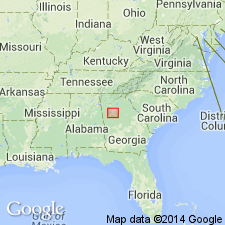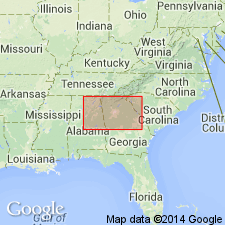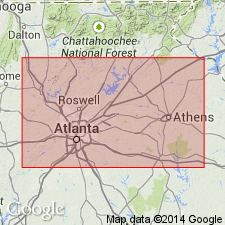
- Usage in publication:
-
- Clairmont Formation*
- Modifications:
-
- Named
- Dominant lithology:
-
- Gneiss
- Amphibolite
- AAPG geologic province:
-
- Piedmont-Blue Ridge province
Summary:
The Clairmont Formation of the Atlanta Group, here named in the Newnan-Tucker synform near Atlanta, GA, consists of well-foliated, contorted, porphyroblastic, biotite-plagioclase gneiss interlayered with amphibolite. Contacts with the underlying Norcross Gneiss and overlying Wahoo Creek Formation are conformable and gradational. It correlates with part of the Senoia Formation. 500 to 1,500 m thick. Age is Late Proterozoic and (or) early Paleozoic.
Source: GNU records (USGS DDS-6; Reston GNULEX).

- Usage in publication:
-
- Clairmont Formation*
- Modifications:
-
- Revised
- AAPG geologic province:
-
- Piedmont-Blue Ridge province
Summary:
The Clairmont Formation is removed from the Atlanta Group, here abandoned. It comprises the Clairmont melange in the Clairmont thrust sheet on the northwest limb of the Newnan-Tucker synform in Georgia. Beneath the main mass of Clairmont melange are rocks formerly mapped as the Inman Yard Formation, abandoned, which are assigned to the Clairmont. The Clairmont is a tectonic melange of fragments, blocks, and slabs of amphibolite, granofels, gneiss, epidosite, metagranite, and quartzite floating in a gneiss matrix. Age is Late Proterozoic to Early Ordovician(?).
Source: GNU records (USGS DDS-6; Reston GNULEX).

- Usage in publication:
-
- Clairmont Member*
- Modifications:
-
- Revised
- Age modified
- AAPG geologic province:
-
- Piedmont-Blue Ridge province
Summary:
Rocks previously mapped as Clairmont Formation are now considered to be a facies of Stonewall Gneiss of allochthonous assemblage. Clairmont paleosome is tectonic melange probably composed chiefly of Stonewall and locally the Clairmont is in gradational contact with undivided Stonewall rocks. Clairmont is therefore reduced in rank to Clairmont Member of Stonewall. Age of the allochthonous assemblage, and therefore the Clairmont, is changed to Late Proterozoic(?) to Middle Ordovician(?) based on a more conservative theory that the allochthonous rocks are 1) probably not older than Late Proterozoic because they are not part of Middle Proterozoic (Grenvillian) basement and 2) they could be as young, but not younger than, the time marking the beginning of closure of the ocean they originated in, as set by the slope reversal marked by deposition of Middle Ordovician Rockmart Slate upon unconformity at top of Upper Cambrian to Middle(?) Ordovician Knox Group and Middle Ordovician Lenoir Limestone.
Source: GNU records (USGS DDS-6; Reston GNULEX).
For more information, please contact Nancy Stamm, Geologic Names Committee Secretary.
Asterisk (*) indicates published by U.S. Geological Survey authors.
"No current usage" (†) implies that a name has been abandoned or has fallen into disuse. Former usage and, if known, replacement name given in parentheses ( ).
Slash (/) indicates name conflicts with nomenclatural guidelines (CSN, 1933; ACSN, 1961, 1970; NACSN, 1983, 2005, 2021). May be explained within brackets ([ ]).

